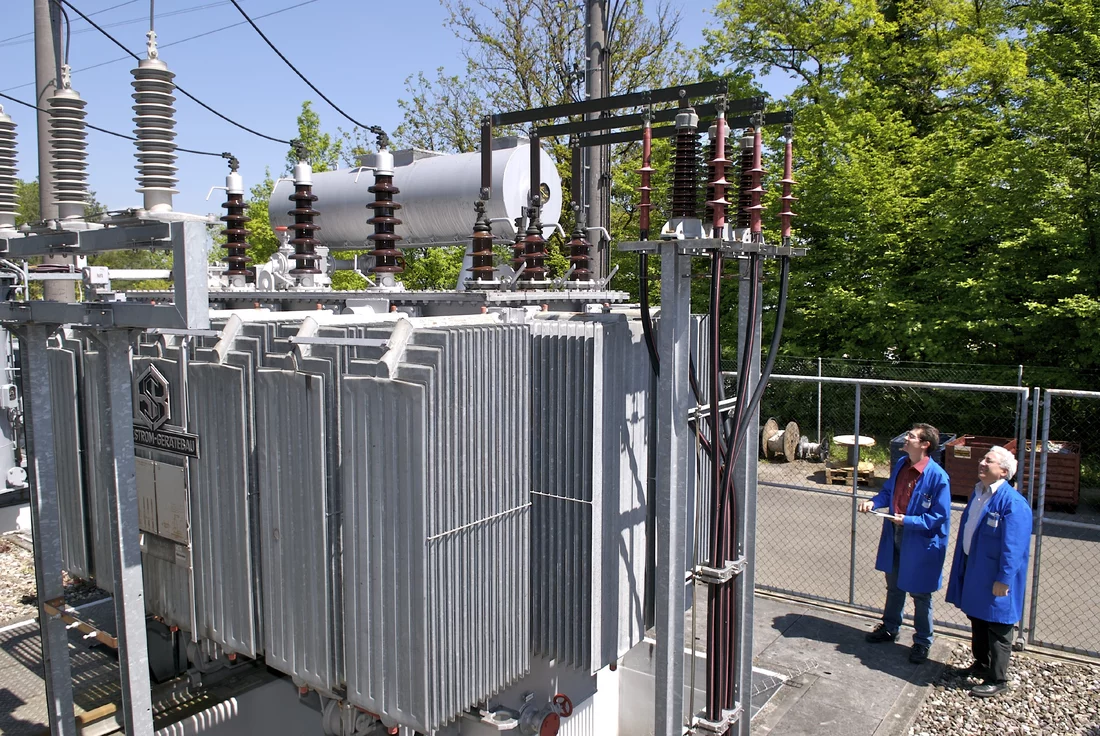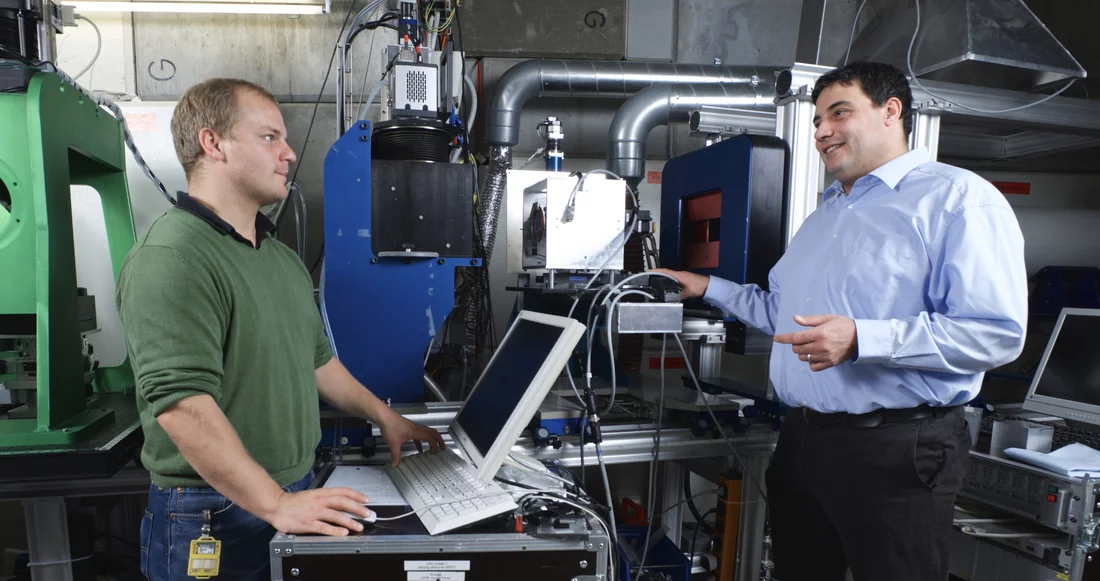Researchers at the Paul Scherrer Institute PSI have found a way of looking inside the iron core of transformers. Transformers are indispensable in regulating electricity both in industry and in domestic households. The better their iron cores are magnetized, the less energy they lose and the more efficiently they work. The groundbreaking investigatory method of neutron grating interferometry developed at the PSI has opened up the possibility of observing magnetic domains at work as they establish magnetic fields inside the iron core. This is a significant step towards understanding how transformers work today and in the development of more efficient transformers in the future—not least because the EU has set new energy-efficiency targets in this field, which Switzerland has also agreed to. Researchers reported on their results in two studies published in the latest edition of the specialist journal Physical Review Applied.
Transformers are an indispensable element in our electricity system: in substations, they transform voltage from low to high so that electricity can be distributed over long distances via high-voltage power lines without losing too much energy. At the other end of the high-voltage power lines, transformers decrease the voltage again so that electricity can be delivered to domestic households at 230 volts.
Nonetheless, there remains room for improvement in this field. Two new studies by a team of neutron-research scientists led by Christian Grünzweig at the PSI have explored and applied a state of the art method which shows tiny magnetic structures in the interior of a transformer at work during the transforming process. The results will contribute towards our understanding of how transformers function today and help develop more efficient models in the future.
Flexibility is key
The transformer’s ring-shaped magnetic iron core is a fundamental element necessary for voltage increase or decrease
, explains Grünzweig. The tiny magnetic domains within the core play an essential role in this process. The magnetic orientation within each domain is uniform. Experts refer to the boundaries between these as domain walls. If the iron core is magnetized, this results, at a microscopic level, in all domains pointing the same way. In other words, the domain walls disappear.
The decisive factor for an efficiently functioning transformer is domain-wall mobility
, says Benedikt Betz, the first author of both studies and doctoral student in Grünzweig’s team. This is because our power lines carry alternating current with a frequency of 50 Hertz. As a result, a transformer’s iron core is re-magnetized 100 times per second, being re-poled from north to south and vice versa in rapid succession. The domains are hence thrown backwards and forwards: the greater their flexibility, the better the transformer performs.
PSI technology looks inside transformers
The methods available so far have only allowed indirect observation of domain-wall behaviour. The neutron grating interferometry developed by Christian Grünzweig at the PSI ten years ago within the framework of his doctoral thesis now permits direct imaging of the domain walls. You can think of the domains as garden plots, separated from each other by fences
, says Grünzweig. Using neutron grating interferometry, we are now able to see these fences—meaning the domain walls; not the garden plots themselves.
In the scientist’s images obtained by neutron grating interferometry, the domain walls appear as black lines.
In a study directed by Benedikt Betz, Grünzweig’s team has investigated what happens when a transformer is connected to a direct current, which is first increased and subsequently decreased again. As the voltage increased, the black lines disappeared, showing that the iron core was uniformly magnetized in one direction. Only in this state does the iron core transfer voltage efficiently. Once the voltage was subsequently reduced, the lines – and the domain walls they represent – reappeared. This first study provided the basis for further investigations.
In a second study, the researchers mimicked a more realistic scenario by applying an alternating current. When varying the voltage and the frequency of the alternating current, they found that there were certain thresholds of each of these parameters, beyond which domain walls either disappeared or appeared to freeze.
Developing efficient transformers
These insights do not lead directly to better transformers
, Christian Grünzweig admits. What we are doing is offering science and industry a new examination method.
And it’s come just at the right moment. Since last year, the EU’s Ecodesign Directive, which Switzerland has also agreed to implement, has urged the energy sector to improve transformer performance. So far, the development of transformers took place more or less on the basis of trial and error: why a new transformer functioned better than an older version was never really clear. This new, more accurate information on the magnetic processes taking place within the iron core will now enable a more target-oriented optimisation of transformers.
The potential for improvement is vast. According to estimates, large distribution transformers lose about 38 terawatt-hours worth of energy annually throughout the EU – more than half the annual energy consumption of Switzerland. Improving transformer efficiency by even just a few percent would lead to savings equating to the power production of several power stations.
Text: Jan Berndorff
Contact
Dr Christian GrünzweigNeutron Imaging and Activation Group, Laboratory for Neutron Scattering and Imaging,
Paul Scherrer Institute, 5232 Villigen PSI, Switzerland
Telephone: +41 56 310 46 62, e-mail: christian.gruenzweig@psi.ch
Original Publications
Magnetization Response of the Bulk and Supplementary Magnetic Domain Structure in High-Permeability Steel Laminations Visualized In Situ by Neutron Dark-Field ImagingB. Betz, P. Rauscher, R.P. Harti, R. Schäfer, A. Irastorza-Landa, H. Van Swygenhoven, A. Kaestner, J. Hovind, E. Pomjakushina, E. Lehmann, and C. Grünzweig
Phys. Rev. Applied 6, 024023 – Published 30 August 2016
DOI: 10.1103/PhysRevApplied.6.024023
Frequency-Induced Bulk Magnetic Domain-Wall Freezing Visualized by Neutron Dark-Field Imaging
B. Betz, P. Rauscher, R. P. Harti, R. Schäfer, H. Van Swygenhoven, A. Kaestner, J. Hovind, E. Lehmann, and C. Grünzweig
Phys. Rev. Applied 6, 024024 – Published 30 August 2016
DOI: 10.1103/PhysRevApplied.6.024024
About PSI
The Paul Scherrer Institute PSI develops, builds and operates large, complex research facilities and makes them available to the national and international research community. The institute's own key research priorities are in the fields of matter and materials, energy and environment and human health. PSI is committed to the training of future generations. Therefore about one quarter of our staff are post-docs, post-graduates or apprentices. Altogether PSI employs 2000 people, thus being the largest research institute in Switzerland. The annual budget amounts to approximately CHF 370 million. PSI is part of the ETH Domain, with the other members being the two Swiss Federal Institutes of Technology, ETH Zurich and EPFL Lausanne, as well as Eawag (Swiss Federal Institute of Aquatic Science and Technology), Empa (Swiss Federal Laboratories for Materials Science and Technology) and WSL (Swiss Federal Institute for Forest, Snow and Landscape Research).
(Last updated in May 2016)
Kontakt/Ansprechpartner
Dr. Christian GrünzweigForschungsgruppe Neutronenradiografie und Aktivierung, Labor für Neutronenstreuung und Imaging,
Paul Scherrer Institut, 5232 Villigen PSI, Schweiz
Telefon: +41 56 310 46 62, E-Mail: christian.gruenzweig@psi.ch
Originalveröffentlichungen
Magnetization Response of the Bulk and Supplementary Magnetic Domain Structure in High-Permeability Steel Laminations Visualized In Situ by Neutron Dark-Field ImagingB. Betz, P. Rauscher, R.P. Harti, R. Schäfer, A. Irastorza-Landa, H. Van Swygenhoven, A. Kaestner, J. Hovind, E. Pomjakushina, E. Lehmann, and C. Grünzweig
Phys. Rev. Applied 6, 024023 – Published 30 August 2016
DOI: 10.1103/PhysRevApplied.6.024023
Frequency-Induced Bulk Magnetic Domain-Wall Freezing Visualized by Neutron Dark-Field Imaging
B. Betz, P. Rauscher, R. P. Harti, R. Schäfer, H. Van Swygenhoven, A. Kaestner, J. Hovind, E. Lehmann, and C. Grünzweig
Phys. Rev. Applied 6, 024024 – Published 30 August 2016
DOI: 10.1103/PhysRevApplied.6.024024


